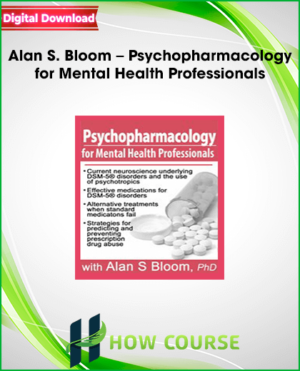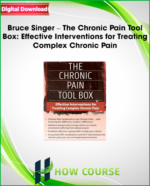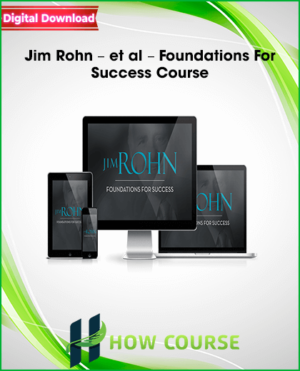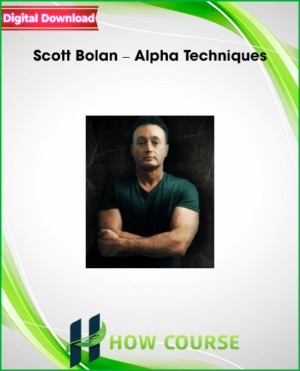Bruce Singer – The Chronic Pain Tool Box: Effective Interventions for Treating Complex Chronic Pain
Faculty:
Bruce Singer
Duration:
6 Hours 11 Minutes
Format:
Audio and Video
Copyright:
Apr 12, 2018
Description
Chronic Pain Syndrome is not Chronic Pain… and knowing the difference makes a difference
Wellness-based tools to help clients un-attach emotional suffering from physical pain
Facilitate effective coping skills to help your clients
8 essential CBT, mindfulness and ACT interventions for chronic pain you can use beginning tomorrow
Years ago, I sat down to evaluate a potential client with chronic pain. A minute hadn’t passed before she broke down in tears while describing a 5-year-old injury that left her with excruciating neck pain. Despite 3 back surgeries and countless procedures, her back was still “killing” her and she placed her pain at 15/10. She couldn’t sleep, she had gained weight and couldn’t exercise. She had stopped working, was in a lawsuit over the injury, and was afraid to leave the house. Her doctor had placed her on high doses of an opiate pain killer plus an anti-anxiety medication and she admitted that sometimes she took more than she was prescribed. She admitted to having suicidal thoughts because she had lost hope that she might ever get her life back.
Now imagine yourself in my place. How would you conduct an effective assessment? Do you know the difference between chronic pain and a chronic pain syndrome? What might be the best approach to treat pain and a co-occurring disorder? Are you confident you have enough evidence-based skills in your toolbox to help clients help themselves?
This is a challenging time to treat complex chronic pain. Over 100 million Americans experience some form of chronic pain and the country is struggling with a tragic opiate epidemic that has cost tens of thousands of lives and is ripping society apart. As a clinician, you are in unique position to provide effective pain management to your chronic pain clients… but only if you fill your invisible toolbox with the evidence-based skills that work.
In this interactive and creative seminar, we will focus on the assessment and treatment of complex chronic pain. You will learn how to evaluate it and how to discern and manage co-occurring disorders. You will increase your confidence in your ability to transform your knowledge of CBT, mindfulness, and ACT into the “silver bullet” skills that can facilitate “inside-out” pain management that empowers your clients. You will leave this seminar with 8 practical interventions you can begin to use tomorrow to motivate your clients to commit to the changes they want and to assist their families in finding the resources they need.
Handouts
Manual (4.17 MB) 74 Pages Available after Purchase
Outline
The Chronic Pain Dilemma
Pain and its impact on society
Neurophysiology and psychology of pain
Benefits and the risks of opioids
Pain and the family
Complex Chronic Pain
The progression from acute to chronic pain (physical and emotional factors)
Chronic pain syndrome and its constellation of symptoms
Conventional treatments and why they fail
Pain vs suffering: What are we really treating?
The 5 big “negative” emotions that magnify pain
The number one rule in pain management
Strategies to un-attach pain from suffering
Assessment
The Interview
Validation and the therapeutic alliance
Collect a biopsychosocial history
Co-occurring disorders and other risk factors
The Battery
Useful self-report measures
Interpretation of results for case conceptualization
Effective treatment planning
The Chronic Pain Toolbox
Best Practice Guidelines and treatment options
APA Division 12 recommendations
CDC and government recommendations
Empathy and the power of the therapeutic alliance
Cognitive Behavioral Therapy
Unleash “black ducks” to eat up ANTs
Harness the power of client’s own words
Recalibrate Pain: a cognitive approach
Mindfulness
Why mindfulness is essential for the treatment of chronic pain
4 creative interventions to help clients see “What is NOT wrong with me”
The FAR approach and how it resonates with clients
Limitations of the psychotherapeutic approach
Acceptance and Commitment Therapy
Cognitive defusion and how to use it with clients
The Values Compass and how to help clients find their True North
Develop motivation and commitment
Limitations of the psychotherapeutic approach
Gratefulness
The hidden power of gratefulness and its evidence for chronic pain
3 gratitude interventions that directly impact the pain experience
More Tools You Can Use
Include the family in treatment
Effective sleep hygiene
Multidisciplinary treatments: when and how to use them
The T.E.M.P.L.E.S.S hand-out you can share with clients
Patient advocate resources
Recovery resources
Faculty
Bruce Singer, Psy.D.
Bruce F. Singer, Psy.D. is a licensed psychologist and nationally recognized expert on psychosocial treatments for chronic pain and substance use disorders. He was the founding director of the Chronic Pain and Recovery Center at Silver Hill Hospital, one of the most prestigious psychiatric hospitals in the United States. He maintains a private practice and consults internationally with treatment centers.
Dr. Singer sits on the Medical Advisory Board of the U.S. Pain Foundation and on the Board of Chronic Pain Anonymous where he is an outspoken advocate for helping individuals with chronic pain obtain effective treatment. An inspirational speaker known for his creativity and sense of humor, Dr. Singer has presented at Grand Rounds and pain and addiction conferences throughout the United States. He is the author of numerous professional articles on psychosocial treatments for chronic pain and substance abuse, and his guided meditations and educational videos are readily available on the web. He recently authored Black Duck Moments Every Day, a book of daily affirmations for people with chronic conditions as well as 99 Black Duck Moments, an eBook based on his original memes and videos.
Speaker Disclosures:
Financial: Bruce Singer is in private practice. He receives a speaking honorarium from PESI, Inc.
Non-financial: Bruce Singer is a member of the Medical Advisory Board for the U.S. Pain Foundation.








